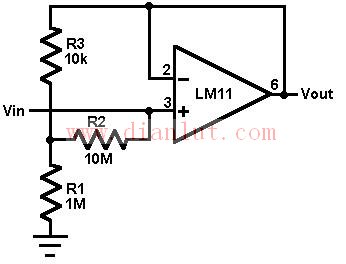
The circuit uses the LM11 to form a 1G ohmic input resistor voltage follower using standard built-in resistor values. When disconnected from the input, the input offset voltage is multiplied by the same factor as R2, but the added error is small because the LM11 offset voltage is so low. This error is reduced when the input source is connected to a no more than 1G ohm. For the ac-coupled input, the second 10M resistor can be connected to the series-inverting input bias current to almost completely eliminate the error, bypassing it will give very little noise.
Features of the voltage follower circuit:
The voltage follower is a common collector circuit, and the signal is input from the base and the emitter is output, so it is also called the emitter output. The base voltage is the same as the collector voltage phase, that is, the input voltage is in phase with the output voltage. The main features of this circuit are: high input resistance, low output resistance, voltage gain is approximately 1, so it is called voltage follower.
So what is the role of voltage following? In a nutshell, the voltage follower acts to buffer, isolate, and improve the load carrying capacity.
The high-impedance input of the common circuit and the low-impedance output make it play an impedance matching function in the circuit, which can make the amplifying circuit of the latter stage work better. A typical example of an application: the signal output of an electric guitar is high-impedance. When accessing a recording device or a speaker, adding this voltage follower before the tone processing circuit will make the impedance match and the tone perfect. This circuit is used in the input part design of many electric guitar effects.
The output voltage of the voltage isolator approximates the input voltage amplitude, and is in a high-impedance state for the pre-stage circuit, and is in a low-resistance state for the latter-stage circuit, thus playing an "isolation" effect on the front-end circuit.
Voltage followers are often used as intermediate stages to "isolated" the effects between the front and back stages, which is referred to as the buffer stage. The basic principle is to take advantage of its high input impedance and low output impedance.
The voltage follower has high input impedance and low output impedance. It can be understood at an extreme point. When the input impedance is high, it is equivalent to opening the circuit of the previous stage. When the output impedance is low, the circuit of the latter stage is equivalent to one. The constant voltage source, that is, the output voltage is not affected by the impedance of the subsequent stage circuit. A circuit that is equivalent to an open circuit to the pre-stage circuit and whose output voltage is not affected by the impedance of the latter stage is of course isolated, even if the circuits of the front and rear stages do not affect each other.
Shenzhen Kate Technology Co., Ltd. , https://www.orelxvape.com